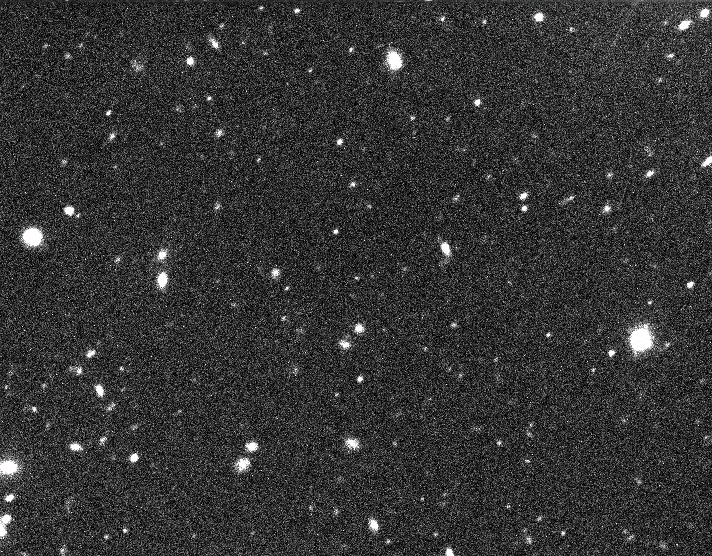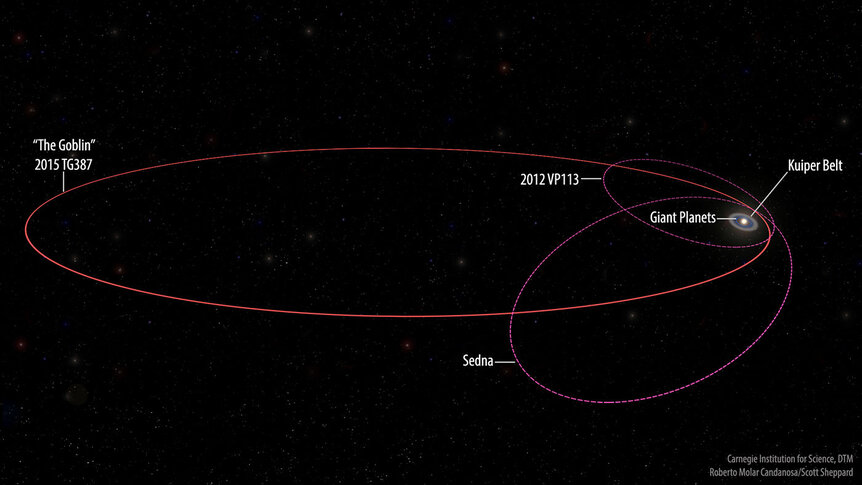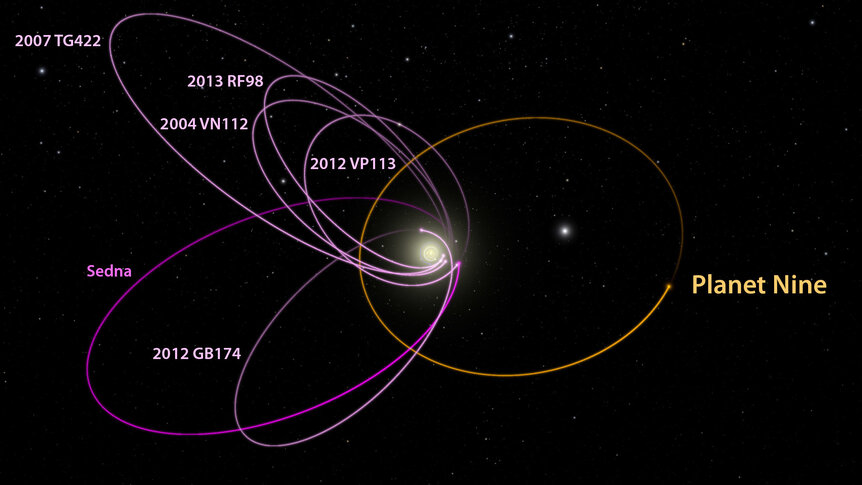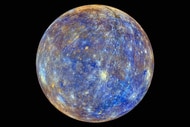Create a free profile to get unlimited access to exclusive videos, sweepstakes, and more!
A newly discovered *extremely* distant icy world points to Planet 9
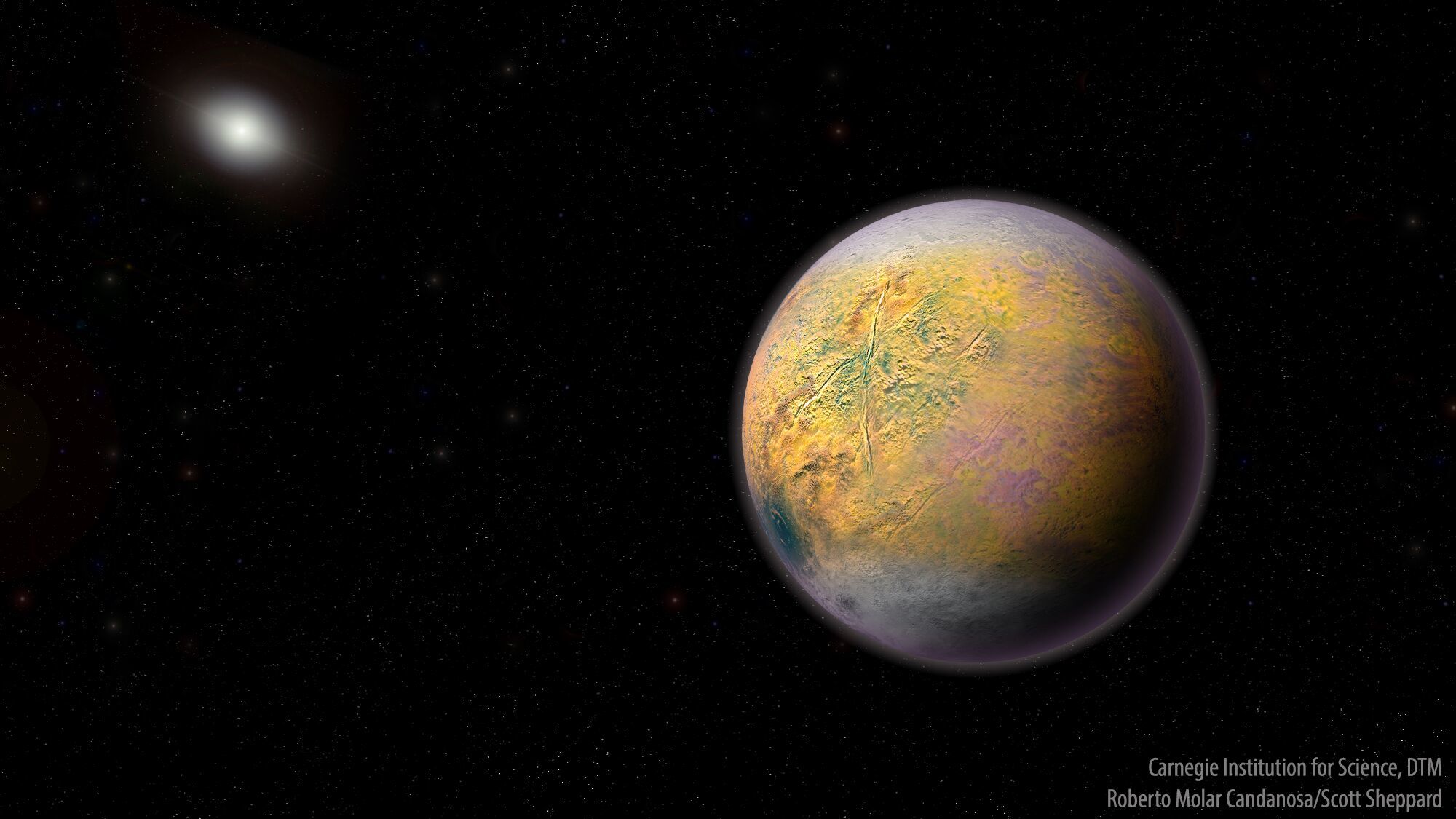
Astronomers have found another extremely remote iceball in the solar system. And oh my do I mean remote: It’s so far away it takes about 40,000 years to orbit the Sun just once. Even more interesting: Its very existence seems to point (literally) to another major planet in the solar system, one that’s been theorized to be out there but hasn’t yet been seen.
The new object is called 2015 TG387, and was discovered in a survey using very big telescopes to scan the sky for very distant objects in the solar system. When it was found, TG387 was 12 billion kilometers away, 80 times the distance of the Earth from the Sun, or about 2.5 times farther from the Sun than Neptune!
Given its distance and how bright it is, astronomers estimate it’s probably about 300 km across. That’s pretty rough; if it’s darker than expected it could be twice that size (it would need to be bigger if it's darker to be as bright as we see it). But either way it ain’t very big; for comparison our own Moon is more than ten times wider than that.
The orbit for TG387 is pretty amazing: It’s well over 2,000 times wider than Earth’s end-to-end — it goes a staggering 350 billion kilometers out from the Sun, and never gets closer than about 10 billion kilometers from our star (nearly twice as far out as Neptune). This means the orbit is extremely elliptical (for the math/astro nerds: It has an orbital eccentricity of 0.945 — an eccentricity of 0 is a circle, and 1 is a parabola, so this is really, really stretched out). It’s moving so slowly and is so faint it took three years of follow-up observations since its discovery in 2015 to nail down its characteristics.
Incidentally, that closest point to the Sun is called perihelion, and only two objects known have larger ones: Sedna and 2012 VP113. If you want to think of it a different way, of all the objects we know of in the solar system, TG387 has the third farthest closest approach to the Sun.
Whoa.
Now, we expect there are lots of objects like this in the solar system, decent-sized icy worlds out there in the black. What makes this object so very, very interesting is the shape and orientation of its orbit.
You can think of the solar system as divided into two very broad regions, the inner solar system with the major planets and asteroids, and the outer solar system populated by icy rockballs (or rocky iceballs) past Neptune. In fact we lump all those latter together into a generic group called Trans-Neptunian Objects, or TNOs.
But there are lots of subdivisions to TNOs. Some orbit just outside Neptune, making up the Kuiper Belt (that’s where you’ll find Pluto, for example), while others are farther out, with tilted orbits, called the scattered disk. Outside that is a huge cloud of these worldlets called the Oort Cloud, and that extends out to about 10 trillion kilometers: a light year!
Many objects in the scattered disk and inner Oort Cloud have highly elliptical orbits. Some get close enough to the Sun (though still really far out) that the gravity of the giant planets can affect them strongly; others stay far enough out that they are only mildly affected, and others are farther out still and scoff at the idea of the planets’ gravity.
2015 TG387 is part of the Inner Oort Cloud, which are the latter. It never gets close enough to the inner solar system to be substantially affected by the inner planets.
And this is where things get weird. All the planets and asteroids (and Kuiper Belt Objects, for that matter) tend to orbit in the same plane; if you looked at the solar system “from the side” it would look flat. But out past the scattered disk you’d expect the objects to have elliptical orbits that are pretty randomly oriented. For example, one might be tilted perpendicular with respect the inner plane; another would be at 20° tilt, another at 45°, and so on. Also, you’d expect the long axis of these orbits to be randomly pointed to any direction on the sky.
But that’s not the case! Not too many objects are known this far out, but it turns out that a lot of them seem to have a preferred direction to their long axis. That’s unexpected; if they are too far out to be affected by the inner planets, why are their orbits more or less aligned?
In 2014, a pair of astronomers proposed the existence of a super-Earth, a relatively massive planet, orbiting the Sun out past the Kuiper Belt. It was the gravity of this planet, over billions of years, that massaged the orbits of those TNOs, aligning them somewhat as tapping a deck of cards on a table top gets them evened out.
Not long after that, two other astronomers calculated possible orbits for this planet (teasingly called Planet Nine, given Pluto’s demotion) by analyzing the orientation of the TNOs that appear to be affected by it. They could even predict what parts of the sky this super-Earth could be in.
That’s what prompted the survey that found TG387 (and also found VP113 back in 2012). And speaking of which, TG387 seems to have an orbit that fits right in with the other objects!
Again, not too many objects are known this far out from the Sun, so we can’t say for absolute certain they’re all affected by this planet — it could be coincidence. Some astronomers have argued just this, saying these surveys are biased, prone to find objects in weird orbits, skewing the statistics. They say their own surveys are less biased and don’t see as many objects that have odd orbits, thus downplaying the possibility of Planet Nine. However, in this most recent work, the astronomers who found TG387 argue those others surveys are incomplete and do suffer from biases. The fact that this new object fits in so well with the others does seem to support the idea that Planet Nine is out there… if their survey truly isn’t biased.
But there’s more, another subtle and complicated effect the astronomers found. It’s possible to simulate the stability of an object’s orbit using computer models. They found TG387 is stable over the lifetime of the solar system, which is nice (though it’s possible that, in some cases, a nearby passing star could tug on it hard enough to change its orbit substantially).
But as I said earlier, by looking at the orientations of TNOs, you can model what the orbit of Planet Nine should be like. Over time, various effects cause Planet Nine’s orbit to subtly shift its own direction. Using that model, the astronomers also found that over time (like billions of years), due to gravitational influences, TG387’s orbit also changes subtly to match Planet Nine’s changes! That’s actually kind of amazing. It doesn’t have to do that, and could have any number of changes to its orbit that could move it in many different ways. The fact that the orbit appears to change in sync with how Planet Nine’s does is very provocative. It doesn’t prove Planet Nine is there, but it shows that seeing TG387 where it is fits even better into the solar system’s overall scheme than you might expect.
And so the search goes on. The survey is continuing. They’re hoping to eventually find Planet Nine, but in the meantime they’re likely to find more objects like TG387. They expect there are something like two million bodies in that region of space bigger than about 40 km wide, so some of them should turn up here and there as we look.
And who knows? Maybe tonight, maybe next week, maybe next year, but sometime, a much brighter and therefore much bigger object — a super-Earth — may very well turn up in the survey. And if it does, we’ll have to re-examine our solar system yet again to understand how it came to be, how it’s changed, and why it looks the way it does now.
